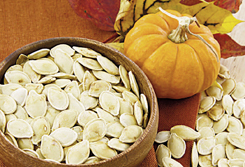
Seeds such as pumpkin, sunflower, chia and sesame are loaded with protein and fibre, calcium and vitamin E, healthy fats and omega-3 fatty acids. And they taste wonderful!
Dr Andrew Saul, in the movie Food Matters, had asked a question — “What would happen if everybody ate lots and lots of fresh organic food that was minimally processed?” In the course of the same movie, he answered his own question by saying, “There would be an epidemic, of health.”
Seeds of all varieties — from chia and flax, to sesame and sunflower — seem to be sprouting in menus everywhere. The organic food industry is also realising this, and seeds are occupying rising popularity as direct ingredients, and not just because of their oils.
Of the six major plant parts, seeds are the dominant source of human calories and protein. The most important global seed food source by weight is obviously cereals (such as wheat, rice, maize, and so on) that are ground to make flour; but legumes and nuts are also popular. Seeds had a major role to play in ancient man becoming a cultivator from a hunter. Cultivation of flax, for instance, has been associated with the establishment of the Babylonian civilization where it was used as food and medicine, as well as to make linen. An Egyptian tomb depicts a baker sprinkling sesame seeds on bread, proving that the practice is as old as the hills.
Sprout some health
Seeds are nutritional powerhouses — loaded with dietary fibre, protein, healthy fats, vitamins, minerals, and antioxidants. There are many types of seeds to choose from, and they’re easy to incorporate into a variety of dishes, adding a boost of flavour, nutrition, and crunch. Chia seeds were used long ago by Mayan and Aztec cultures to boost energy. Similarly, flax seeds are rich in omega-3 fatty acids, dietary fibre, and lignans (beneficial plant compounds). Recent studies show flaxseeds may help reduce belly fat and lower your risk of heart disease, cancer, stroke, and diabetes. Sesame seeds, used to make tahini, are immensely popular in Asian cuisine and are a great source of calcium, iron, magnesium, phosphorus, zinc, B vitamins, and dietary fibre. Due to their antioxidants, a recent study showed sesame oil may help lower inflammation and improve brain health.
Planting an array of tasty seeds in daily cooking is an economical way of sneaking in an extra dose of nutrition without any fuss.
For years, nutritionists have been urging us to eat nuts in place of high-carb and sugary snacks. Dr Anupam Sharma, a Californiabased cardiologist says, “Peanuts, almonds, walnuts, pistachios, hazelnuts and pecans, as part of a diet low in saturated fats and cholesterol, may help reduce the risk of heart disease.”
Karishma Rawat, a Mumbaibased nutritionist, says, "When mixed with water, chia seeds create a gel that’s touted to be a weightloss pudding that helps control hunger," while adding that aeeds do the double task of satiating hunger as well as giving more nutrition than even a serving of fruit.
Seeds such as pumpkin, sunflower, chia and sesame would be worthy candidates for a similar push, since they too are loaded with many of the same nutrients — protein and fibre, calcium and vitamin E, healthy fats and omega- 3 fatty acids. And oh, yes, they taste wonderful!
A seedful of taste
Seeds give dishes great texture and wonderful satiety. They are used to thicken sauces in Mexico (like mole) and the Mediterranean (like tahini and pesto); they add flavour and a touch of luxury to pilafs, stirfries and desserts throughout West Asia and Asia. “Nutritious seeds add flavour as well as interesting texture to almost any dish and are fun to experiment with,” says Chef Ashay Dhopatkar, Executive Chef at Delhi’s A Ta Maison.
Soaking seeds for seven hours or longer breaks down phytic acid and protease inhibitors and makes the seeds’ nutrients more readily available (this is also true, say many, when you soak and sprout grains). Chef Nishant Choubey, of Dusit Devarana adds seeds to a lot of his salads. “A fruit or vegetable salad is the easiest way in which you can incorporate seeds in your diet. I soak a tablespoon of sesame seeds in rice vinegar with salt and sugar and use that as a dressing on cucumber ribbons to make a delicious salad.” For those with a sweet tooth, Chef Choubey suggests making a seed granola bar, which kids and adults will love, and says, “Simply melt jaggery on very low heat and add your choice of roasted seeds and some nuts or oats. Set in the fridge.”
Seeds can be consumed on their own, or added to breads and even rotis. “Sesame, flax and pumpkin seeds can be added, still moist, to the bread, but to make cookies or garnish dishes, I dry them out in a low oven,” says Chef Ashay.
